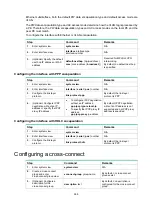
387
2.
Configure BGP AS number substitution:
# Configure BGP AS number substitution on PE 1, PE 2, and PE 3. For more information about
the configuration, see "
Configuring BGP AS number substitution
."
# Display routing information on CE 2. The output shows that CE 2 has learned the route
100::/96 from CE 1. A routing loop has occurred because CE 1 and CE 2 reside in the same
site.
<CE2> display bgp routing-table ipv6 peer 10:2::2 received-routes
Total number of routes: 2
BGP local router ID is 12.1.1.3
Status codes: * - valid, > - best, d - dampened, h - history,
s - suppressed, S - stale, i - internal, e - external
Origin: i - IGP, e - EGP, ? - incomplete
* >e Network : 100:: PrefixLen : 96
NextHop : 10:2::2 LocPrf :
PrefVal : 0 OutLabel : NULL
MED :
Path/Ogn: 100 100?
* >e Network : 200:: PrefixLen : 96
NextHop : 10:2::2 LocPrf :
PrefVal : 0 OutLabel : NULL
MED :
Path/Ogn: 100 100?
3.
Configure BGP SoO attribute:
# On PE 1, configure the SoO attribute as 1:100 for CE 1.
<PE1> system-view
[PE1] bgp 100
[PE1-bgp-default] ip vpn-instance vpn1
[PE1-bgp-default-vpn1] address-family ipv6
[PE1-bgp-default-ipv6-vpn1] peer 10:1::1 soo 1:100
# On PE 2, configure the SoO attribute as 1:100 for CE 2.
[PE2] bgp 100
[PE2-bgp-default] ip vpn-instance vpn1
[PE2-bgp-default-vpn1] address-family ipv6
[PE2-bgp-default-ipv6-vpn1] peer 10:2::1 soo 1:100
Verifying the configuration
# PE 2 does not advertise routes received from CE 1 to CE 2 because the same SoO attribute has
been configured. Display the routing table of CE 2. The output shows that the route 100::/96 has
been removed.
<CE2> display ipv6 routing-table
Destinations : 4 Routes : 4
Destination: ::1/128 Protocol : Direct
NextHop : ::1 Preference: 0
Interface : InLoop0 Cost : 0






























